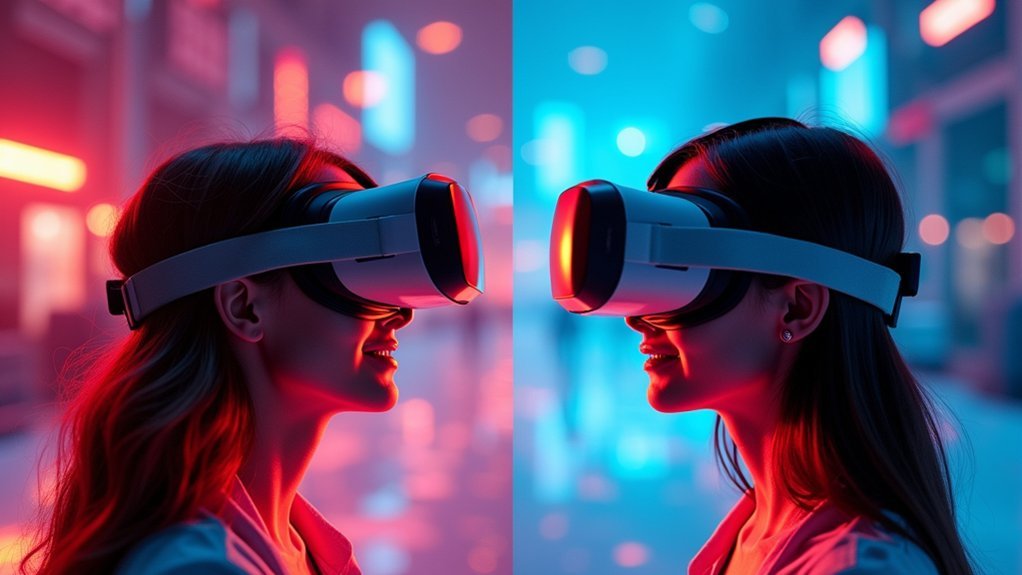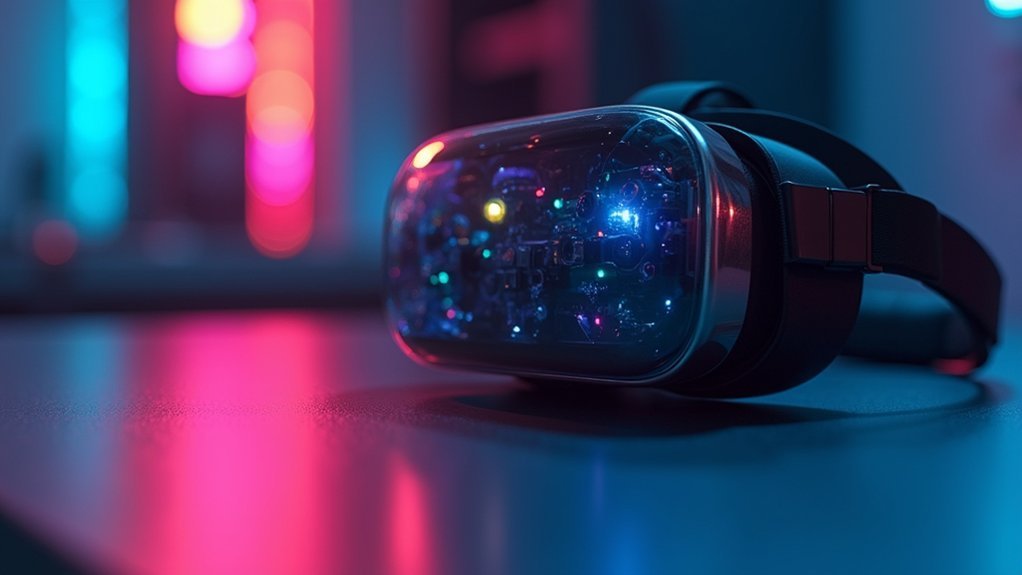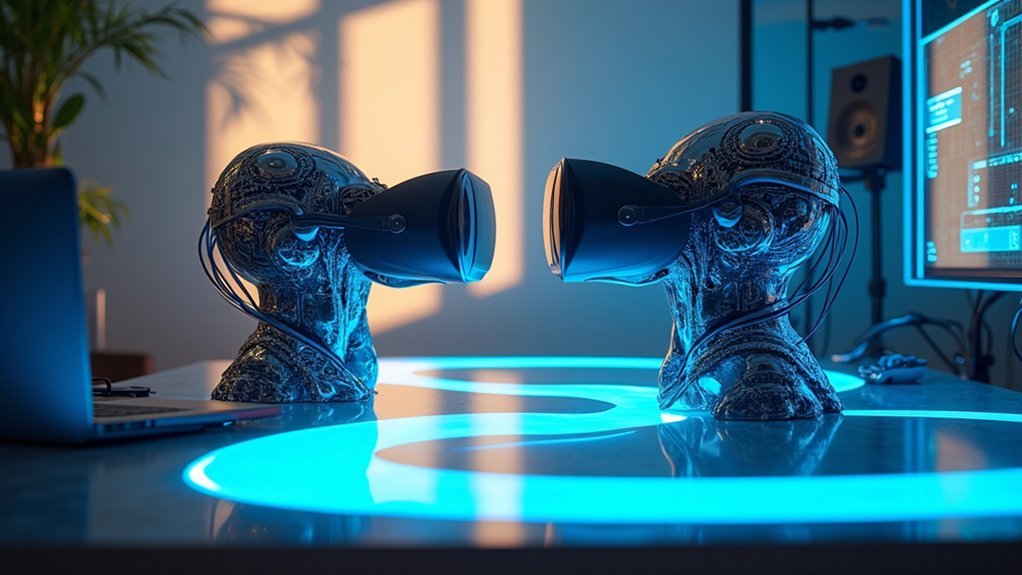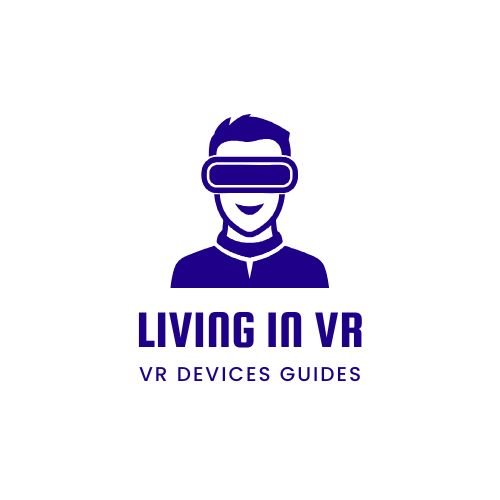You’ll want Photon if you’re building intimate VR experiences for 4-16 players, as its peer-to-peer architecture reduces latency by up to 50% and offers native cross-platform support for all major VR headsets. Choose Mirror for larger VR gatherings with 8+ players, where its server-client model provides better scalability, prevents cheating, and maintains reliable synchronization. While Photon enables rapid prototyping within hours, Mirror requires more development time but delivers superior security and performance stability for complex multiplayer scenarios.
Real-Time Performance Comparison Between Photon and Mirror in VR Environments

When choosing between Photon and Mirror for your VR project, you’ll find that each networking solution excels in different scenarios based on your player count and performance requirements.
Photon’s peer-to-peer model delivers reduced latency for smaller VR lobbies containing 4-16 players, making it ideal for intimate multiplayer game experiences. You’ll appreciate Photon’s rapid setup and deployment capabilities when you’re quickly iterating and testing real-time environments.
Photon’s peer-to-peer architecture excels in small VR multiplayer sessions, offering quick deployment for rapid development cycles.
However, Mirror’s server-client architecture proves superior for larger-scale VR applications requiring many simultaneous connections. Mirror’s server authority guarantees consistent performance in crowded environments, minimizing desynchronization issues that could disrupt your VR experience.
While both solutions work as third party networking tools and are best viewed with JavaScript enabled documentation, Mirror’s robust scalability makes it preferable for complex, high-stakes multiplayer VR games.
Server Architecture Differences: Peer-To-Peer Vs Client-Server Models
You’ll find that Photon’s peer-to-peer architecture connects players directly after initial discovery, reducing latency for small VR lobbies while cutting server costs.
Mirror’s client-server model maintains centralized authority through dedicated servers, providing better control and synchronization for larger multiplayer experiences.
These architectural differences greatly impact your VR game’s performance, with P2P offering speed advantages for intimate sessions while client-server models deliver superior stability and anti-cheat protection.
P2P Latency Advantages
Since Photon’s peer-to-peer architecture allows direct connections between clients, you’ll experience considerably lower latency compared to Mirror’s client-server model where all data must travel through a central hub.
This direct communication path eliminates intermediate server processing, making it particularly valuable for VR applications where even milliseconds matter for immersion.
The P2P latency advantages become especially apparent when viewed with JavaScript enabled networking comparisons, showing Mirror vs. Photon performance metrics:
- Direct player-to-player communication reduces data travel time by up to 50%
- Fewer network hops eliminate bottlenecks that occur in centralized systems
- Real-time interactions feel more responsive during hand tracking and gesture recognition
- Reduced server load prevents performance degradation as player count increases
Server Authority Benefits
While Photon’s P2P model excels at minimizing latency, Mirror’s client-server architecture provides server authority that brings significant security and game integrity advantages to VR multiplayer experiences.
You’ll benefit from centralized control that prevents cheating and maintains consistent game states across all players. Mirror’s authoritative server validates every player action and movement, ensuring fairness in competitive VR environments where precision matters most.
You can handle larger player bases more reliably since the dedicated server manages all interactions rather than relying on individual devices.
This architecture enables sophisticated game state management and authoritative validation that’s essential for maintaining immersive VR experiences. Unlike Photon’s device-dependent hosting, Mirror’s server authority scales effectively while preserving gameplay quality.
VR Performance Impact
The fundamental architectural differences between Photon’s peer-to-peer model and Mirror’s client-server approach create distinct performance profiles that directly impact your VR experience.
Photon’s peer-to-peer connection reduces initial latency for small groups but hits bandwidth walls as player counts grow. Each participant’s internet connection becomes a potential bottleneck, creating inconsistent frame rates that can trigger VR motion sickness.
Mirror’s centralized server architecture delivers more predictable performance by managing all network traffic through dedicated infrastructure. This consistency proves essential for VR applications where frame drops and lag spikes can break immersion.
- Small lobbies (2-4 players): Photon often provides lower latency
- Large groups (8+ players): Mirror maintains stable performance
- Connection quality varies: Photon suffers more from weak links
- Server resources: Mirror offers scalable bandwidth allocation
Latency and Synchronization Requirements for Immersive VR Experiences
When you’re developing VR applications, latency becomes your biggest enemy in the fight against motion sickness and broken immersion.
You’ll find that Photon’s peer-to-peer architecture excels at minimizing delays by connecting players directly, making it ideal for small lobby games with 4-16 players where split-second reactions matter.
Mirror’s server-to-client model takes a different approach, prioritizing consistent synchronization through authoritative server updates.
While this might introduce slightly higher latency, you’ll benefit from more reliable state management across larger player counts.
Trade-offs matter: accept minimal latency increases for rock-solid synchronization when managing complex VR worlds with many players.
Both platforms optimize packet sizes and update frequencies, but your choice depends on scale.
You’ll want Photon for intimate, fast-paced VR experiences, while Mirror’s stability shines in complex, large-scale multiplayer environments requiring detailed state information.
Cross-Platform VR Headset Compatibility Analysis

Building cross-platform VR experiences requires careful consideration of how different headsets communicate through your chosen networking framework.
Photon excels in this area with native cross-platform support that seamlessly connects Meta Quest, HTC Vive, and Oculus Rift users without extensive configuration.
Here’s how each framework handles cross-platform compatibility:
- Photon’s peer-to-peer architecture enables direct connections between different VR platforms, reducing latency for real-time interactions.
- Mirror requires additional setup and server management to achieve cross-platform functionality, though it’s certainly possible.
- Photon’s streamlined approach makes cross-platform development more accessible for developers without extensive networking experience.
- Mirror’s server-client model provides better authoritative control but may limit some cross-platform interactions.
Both frameworks offer community resources to help you overcome compatibility challenges for your specific VR project needs.
Scalability Limitations and Player Count Considerations
Cross-platform compatibility becomes considerably more complex as your VR project scales beyond small groups of players.
You’ll find Photon works best for intimate VR experiences with 4 to 16 players, making it perfect for small lobby games.
However, if you’re planning larger VR gatherings, Mirror’s architecture handles many simultaneous connections more effectively.
Photon’s peer-to-peer system creates scalability bottlenecks as player counts increase, potentially causing connection issues during peak activity.
You’ll experience better performance with Mirror’s server-to-client model, which manages large groups efficiently and reduces lag risks.
When you’re designing VR projects requiring extensive player interaction, Mirror’s larger-scale connection capabilities give you a significant advantage over Photon’s more limited capacity for handling crowds.
Setup Complexity and Development Time Investment

While Photon’s streamlined setup process gets you multiplayer functionality running within hours, Mirror’s more complex server architecture demands considerably more development time upfront.
Photon delivers instant multiplayer deployment while Mirror’s intricate architecture requires substantial upfront development investment.
When you’re choosing between these networking solutions for VR development, consider these key time investment factors:
- Initial Configuration – You’ll configure Photon’s peer-to-peer system quickly, while Mirror’s server-client model requires extensive setup and architecture planning.
- Learning Resources – Photon provides extensive tutorials and community support, whereas Mirror often leaves you searching for additional documentation.
- Code Adaptation – Converting single-player games to multiplayer happens rapidly with Photon, but Mirror necessitates significant codebase reworking.
- Prototyping Speed – Photon’s user-friendly approach accelerates quick iterations, while Mirror’s complexity slows prototyping phases considerably.
For VR projects prioritizing rapid development cycles, Photon’s reduced complexity proves advantageous.
Cost Analysis: Free Vs Paid Hosting Solutions for VR Projects
You’ll find that free hosting options come with significant constraints on concurrent users and features that can limit your VR project’s growth potential.
However, you can’t ignore that paid solutions offer substantial scaling benefits, including higher player capacity and advanced networking features essential for immersive multiplayer experiences.
Your choice between free and paid hosting will ultimately determine whether you’re building a prototype or launching a commercial VR application.
Free Hosting Limitations
Although free hosting solutions appear attractive for VR developers on tight budgets, they come with significant constraints that can impact your project’s success.
Key limitations you’ll face with free hosting:
- Concurrent User Restrictions – Photon’s free tier limits your CCU capacity, forcing you to upgrade for larger VR experiences, while Mirror doesn’t impose these networking restrictions.
- Performance Degradation – Photon’s peer-to-peer model struggles with high player counts on free plans, creating latency issues that break VR immersion.
- Limited Server Resources – Free hosting typically provides minimal bandwidth and processing power, inadequate for demanding VR applications requiring real-time synchronization.
- Scalability Barriers – You’ll hit walls when trying to expand your player base, making free solutions unsuitable for commercial VR projects expecting growth.
Paid Scaling Benefits
When your VR project outgrows free hosting constraints, paid scaling solutions deliver measurable performance improvements and revenue opportunities that justify their costs.
Photon’s cloud hosting offers seamless scalability with pay-as-you-go pricing, letting you manage expenses based on actual player usage as your audience expands. You’ll avoid upfront infrastructure investments while maintaining reliable performance during traffic spikes.
Mirror’s paid scaling approach differs markedly. You’ll need to invest in dedicated servers for high-traffic scenarios, but this gives you complete control over your hosting environment.
While initial costs are higher, you can optimize server configurations specifically for your VR project’s requirements.
Both solutions transform from cost centers into revenue enablers when properly implemented, supporting larger player bases that generate sustainable income streams.
Security and Anti-Cheat Capabilities in Virtual Reality Gaming
Security breaches in VR gaming can devastate player trust and compromise entire virtual worlds. When choosing between Photon and Mirror for your VR project, you’ll find significant differences in their security approaches that directly impact your ability to prevent cheating.
Mirror’s server-to-client architecture gives you superior control over game state validation. You’ll benefit from centralized authority that prevents unauthorized actions, while Photon’s peer-to-peer model creates more vulnerability points for potential exploiters to target.
Key security considerations for your VR networking choice:
- Server Authority – Mirror’s built-in authoritative controls validate all critical game actions server-side.
- Communication Security – Photon provides encryption but requires additional developer-implemented security measures.
- Architecture Vulnerability – Peer-to-peer connections increase cheating risks compared to centralized validation.
- Anti-Cheat Implementation – Mirror’s server-centric design facilitates easier deployment of extensive anti-cheat systems.
Community Support and Documentation Quality Assessment
How quickly can you resolve critical VR networking issues when they arise in production? Your success depends heavily on community support and documentation quality.
Photon excels with abundant tutorials and beginner-friendly resources, plus an active Discord community enabling real-time problem-solving discussions. You’ll find extensive documentation with detailed guides and API references that streamline troubleshooting.
Mirror’s community actively discusses various topics and offers a platform for sharing experiences, though users want more thorough tutorials.
However, Mirror’s documentation receives praise for thoroughness and clarity in explaining features.
Both platforms provide extensive documentation access, but Photon’s broader range of learning materials and collaborative Discord environment give you faster pathways to solutions when facing urgent VR development challenges.
Frequently Asked Questions
Is Fishnet Better Than Mirror?
You’ll find Fishnet better than Mirror if you’re developing smaller VR projects requiring low latency and simple integration. However, you’d prefer Mirror for larger multiplayer environments with extensive community support.
What Is the Best Multiplayer Tool for Unity?
You’ll find Mirror’s the top choice for larger Unity multiplayer projects due to its scalability and cheat prevention. For smaller games, Photon’s simplicity and quick setup make it ideal for rapid development.
Is Photon Unity Good?
You’ll find Photon Unity excellent for multiplayer development. It’s beginner-friendly with quick setup, supports 4-16 players seamlessly, includes built-in lobbies and chat, offers extensive tutorials, and provides free access for indie developers.
What Is a Mirror Network?
Mirror network’s a free Unity networking solution you’ll use for multiplayer games. It supports server-to-client architecture, handles large player counts, works on LAN and internet, and integrates seamlessly with Unity’s framework.





Leave a Reply